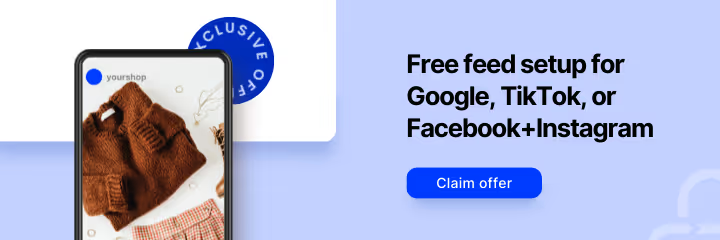Google Shopping has evolved greatly since the early days. From Froogle to Product Search, from Product Listing Ads to Google Shopping, one thing remains clear: however you look at it, Google product listing ads work because they’re powered by Google’s popular search engine, which attracts 178 million unique visitors each month.
You can't afford NOT to list your products on the one search engine almost everyone is using, so the question is not “Should you list on Google Shopping?”, but rather, “How?”
To help answer the many variations of this question, we’re bringing you a series of blog posts based on your most frequently asked questions from our recent Webinar on Google Shopping.
We’ll start off with a popular functionality of Google Shopping and how it applies to what GoDataFeed does (and how we can help you do it better).
Using Google Shopping Custom Labels
Will custom labels created in GoDataFeed be visible in my Google Shopping campaigns?
Yes. As you set up your product groups in your Google Shopping campaign, you’ll see an edit button that looks like a pencil icon. Click it to select brand, product type, condition, ID and all of the custom labels from your feed and see them in Adwords for segmentation.

Can I use multiple custom labels for use on one campaign?
Yes. When you start segmenting your products in Google Shopping campaigns, no matter what the attributes are, you can segment them in multiple ways. The beauty of multi-label segmentation is that you can have one product in multiple categories so that you can gather data and eventually determine what category that product performs better in. Ultimately, you can leverage this data using GoDataFeed to promote top-performing products and lower bids on products that underperform.

I would like to be able to see profit versus advertising cost. Can I add my product cost into my data feed?
There are a couple of ways to do this.
If you can supplement performance data into the feed that we take in from your ecommerce platform, we can then set rules based on margins or cost data and then create custom labels based on those thresholds. As our system updates these products, it will automatically regroup your products in Adwords.
If you have a high-performing product whose margins drop because the cost suddenly goes up and it becomes too costly to promote, we can use the pre-set thresholds in your feed to automatically lower the bid.
Learn More: Request a Live Demo
TIP: Another way to do this is by using GoDataFeed’s analytics. Simply put a piece of code on your product page, then determine click, conversion and revenue goals in your GoDataFeed dashboard. Based on this data you can determine how to bid on the particular products. Our Analytics can help you protect your ROI and, ultimately, your margins.
Can I break down the products or product level by using the product name instead of the product ID?
No, but what you can do is create custom labels to put products into groups that allow you to see the names. Unfortunately, if you have a lot of products, there is no way around using the product ID as the main identifier. Keep in mind, however, that this is a problem unique to merchants that are NOT using GoDataFeed. If what you are trying to do is identify and optimize high-performing products, GoDataFeed can help you do this quickly and easily.

What are the best practices for products with a parent-child relationship where two options outsell the others?
This is a perfect example of how you should be using custom labels to segment products. If you have the label broken out into its own category, you can segment those products down to the item level and bid higher on the better-performing options and less on the underperformers.
You can create automated custom rules in GoDataFeed based on performance and margin data to create Custom Labels that in AdWords correspond to a higher bid.
Learn More: Download the Google Shopping Campaigns White Paper
Segmentation and Categorization
Our shopping campaign ads have a high bounce rate. Why do we have success from PPC but not shopping campaigns?
Segment your data down to product level in your shopping campaigns. Look beyond click through rates to impression share. Identify products that get a lot of impressions but have high bounce rates, high click costs and low conversion rates. Reduce bids on these products -- or suppress them altogether. This will let you drive traffic to other products that perform better.
This is a trial-and-error, a/b testing scenario so you have to stay on top of your your bids by adjusting as necessary. Continue to optimize bids until you start to see your bounce rate go down and your conversion rate go up. Please note that GoDataFeed lets you set up performance-based rules that alert you and/or automatically remove underperforming products from your feeds to maximize profitability.
Is it better to segment your products down to the product level or should we follow the categorization of our website?
The beauty of Google Shopping Campaigns is the ability to segment your products into Product Groups, and if needed, down to the product level. This allows you to have different bidding strategies for your product groups. But whether or not you take advantage of this depends on two things: 1) how many products you have and 2) how you want to manage your products.
If your website has a lot of products, you probably want to avoid segmenting down to the product level and instead may segment using your store's internal categorization. If you find that this is simply too much to manage, identify categories that convert well and only segment these categories down to the product level. For categories that don't perform as well, use category bidding. This way you can take advantage of segmentation for those products that are more likely to boost your ROAS.
Is there a difference between the Google product category and the Product type?
Yes, there is a big difference. Google accepts both for listing categorization, but Product Type is usually based on your store's internal product categorization while the Google product category come from Google's own taxonomy and is entirely independent of your own store's categorization. Google product categories have more or less 6,000 categories that you can map your products to. And although it is not required, using Google product taxonomy improves your products' indexing in Google Shopping by giving the engine a better understanding of what your products are.
We recommend mapping your products in your data feed to the Google product category as a best practice.
PLA Best Practices & GoDataFeed
Can GoDataFeed limit our title and descriptions automatically so the product does not get rejected?
Yes. We automatically truncate titles and descriptions to Google Shopping specifications so you don't have to do it manually. This prevents products from getting rejected over character limits. But that's not all. GoDataFeed pre-qualifies your feeds so the data in general is up to code; that way, you know what aspects of your feed need optimization before you even submit them to Google.
Titles, for example, have a 150 character limit but Google recommends between 25 and 70 characters because only 70 characters show up in listings. That's why we recommend frontloading the most important keywords while being descriptive and writing titles in a way that makes sense to shoppers (not Google). Google is going to look from the beginning of the title and determine the keywords (aka, search queries) the product should show up for.
Why should I use a datafeed service like GoDataFeed over using the feed from our shopping cart?
Merchants often copy and paste product information (titles, descriptions, details, etc.) directly from manufacturers. This results in thousands of merchants publishing the same product data to Google Shopping.
By using a data feed software service like GoDataFeed, you can go beyond a basic "data dump." We can merge data to improve the quality of your titles and descriptions so they're not only unique but also more relevant to Google AND the consumer. The difference, is in the quality of your feed. For instance, your titles on your website do not typically have color, size or similar attributes (these are typically options listed in separate sections). We can add these options into your Google Shopping feed to make your product listing ads unique while maintaining the title on your website short and descriptive.
In other words, by using a data feed service like GoDataFeed, you capture your product listing's full potentially and avoid missing out on following best practices. If you're familiar with the principles of the Google Ads' Quality Score and Ad Rank, you know that, with bids being equal, better ads equal better positioning. That often translates to better click-through rates and better conversions, too.
Google Ads vs Google Shopping
Does performance with Google Shopping have any bearing on my Google Ads performance or spend?
No, each campaign is autonomous. Ad rank, quality score and spend are unique to ad groups, ads and budgets of each campaign.
Your spend for the entire account, however, is in Adwords. That includes shopping campaigns, so whatever you spend in Google Shopping will be added to your overall account budget.
How do the new Google Shopping Ads affect my existing PLAs? Do they work together or are the new ads replacing the PLA’s all together?
AdWords now requires product listing ads to run on a Google Shopping-specific campaigns. Your existing Product Listing Ads campaigns will no longer be active and you’ll need to set up new shopping campaigns to manage PLAs.
Google Shopping Ads offer more features than the old PLA campaigns did. The main difference is how the structure of the campaigns have changed within the Adwords interface, but there are some key changes to features as well. The new Google Shopping Ads use product groups, not product targets, to organize your campaigns. Google Shopping Ads use custom labels, not "adwords grouping” or "adwords labels" attributes.
Finally, the term “Product Listing Ads” will still be used, only now it is strictly to refer to the ads that display on Google Shopping Ads.
To put it simply...
- Product Listing Ads = type of ad
- Google Shopping Ads = type of campaign
Not Just Feeds. Smart Data.
As you can see, GoDataFeed does more than just update your Google Shopping feeds. It allows you to harness our intelligent automation features to optimize your Google Shopping campaigns . Our goal is to empower you with smart data feeds that will outperform your competitors.
Whether you plan on managing your feeds yourself or you want a managed solution, we help you sell your products everywhere.





%20).webp)